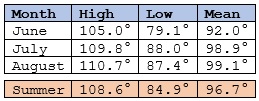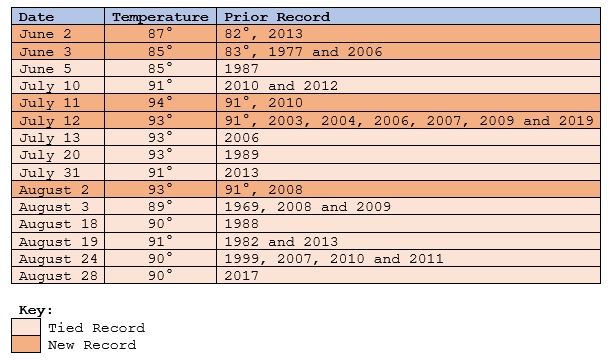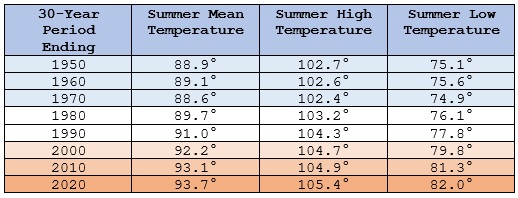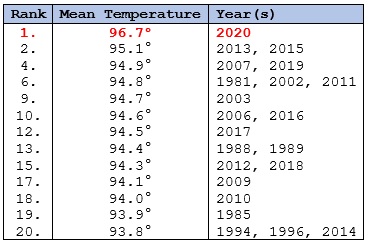PRINT AS PDF
Phoenix concluded, by far, its hottest summer on record. During June-August 2020, Phoenix had a mean temperature of 96.7°. That smashed the old record of 95.1°, which was set in 2013 and tied in 2015.
Table 1: Summer 2020 Average Temperatures

Since 2009, every summer has ranked among the 20 warmest summers on record. In addition, 2015, 2016, 2019 and 2020 have ranked among the 10 warmest summers.
Monthly Mean Temperatures:
June: 92.0° (21st warmest June on record)
July: 98.9° (warmest July on record; old record: 98.3°, 2009)
August: 99.1° (warmest August on record; old record: 98.3°, 2011)
July 2020 set a new monthly mean temperature. August 2020 surpassed that record.
Just 3 (15%) of the 20 warmest months were recorded prior to 2000. 17 (85%) of the warmest months occurred 2000 or later and 10 (50%) of the warmest months occurred 2010 or later.
There were three cases where both July and August ranked among the 20 warmest months: 2007, 2019 and 2020.
Table 4: Record High Minimum Temperatures

Table 5: Record High Maximum Temperatures

Select Monthly Heat Thresholds:
Highs 110° or above: 22 days, August 2020 (old record: 19 days, July 2020; prior old record: 18 days, June 1974)
Highs 115° or above: 7 days, August 2020 (tied record set in June 1974)
Lows: 90° or above: 16 days, July 2020 (old record: 11 days, July 2006); August 2020 had 12 such days.
Select Summer Heat Thresholds:
Highs 110° or above: 48 days (old record: 31 days, 2007 and 2011)
Highs 115° or above: 13 days (old record: 7 days, 1974)
Lows: 90° or above: 28 days (old record: 15 days, 2003 and 2013)
Climate Change:
Anthropogenic climate change is driving a warming of Phoenix’s summers. The warming has accelerated in recent decades. The observed global warming since the 1950s is unequivocal with anthropogenic greenhouse gas emissions being the dominant driver of that warming (IPCC Climate Change Synthesis Report 2014). The warming is a global phenomenon with 98% of the world having experienced its warmest 51 years during the current 2,000 years (Neukom, et al. 2019).
Recent research suggests that Phoenix’s climate will resemble that of Baghdad by 2050 (Bastin, et al. 2019). During the summer, Baghdad typically receives no rainfall. Baghdad’s average high temperatures (Weather Atlas 2002-2020) during the summer months are:
June: 105.8°
July: 111.2°
August: 109.4°
Summer Average High Temperature: 108.8°
Until summer 2020, the highest mean summer maximum temperature was 107.0°, which was set in 1978 and tied in 1989. The highest monthly summer maximum temperature was 109.8°, which was set in July 1989 and tied in July 2020. August 2020 surpassed that record with an average high temperature of 110.7°.
As recently as 2000, Phoenix’s average low temperature during the summer was 79.8°. Since 1999, Phoenix has had no summer with an average low temperature below 80.0°. Prior to 2020, the highest average monthly minimum temperature was 87.5°, which was set in August 2011. July 2020 had an average minimum temperature of 88.0°.
Based on the above research findings, summer 2020 provides a glimpse of what a typical Phoenix summer will be like by 2050.
Table 6: Average Summer Temperatures (30-Year Moving Average)

Climate change is also resulting in an increase in the frequency of days on which the low temperature stays at or above 90° and the high temperature reaches 100° or above, 110° or above, and 115° or above.
Table 7: Average Annual Days at Set Thresholds (30-Year Moving Average)

According to the Fourth National Climate Assessment, Phoenix saw 60 to nearly 100 100° days per year at the 5th and 95th percentiles. Under the RCP 4.5 scenario, those figures are projected to increase to 110-141 days per year during the 2070-2099 period. During the 1950-1999 period, 9 (18%) of years saw the number of 100° days fall within the projected RCP 4.5 interval (U.S. Global Change Research Program, 2017). From 2000-2019, 11 (55%) of years fell within that interval. 2020 is all but certain to become the 12th case since 2000 to meet that higher interval. Moreover, through August 31, the 30-year moving average is just above 110 days per year.
During the summer, 48 days saw high temperatures 110° or above. The previous summer record was 31 days, which was set in 2007 and tied in 2011. During 2020, there have been 50 such days vs. the prior record of 33 days, which was set in 2011. There were also 28 days on which the minimum temperature was 90° or above, which eclipsed the previous record of 15, which was set in 2003 and tied in 2013.
In addition, the number of very hot (high temperature of 110° or above) and super hot (high temperature of 115° or above) days has been increasing as a share of the increasing number of 100° days. For the 30-year period ending in 1980, 12.6% of 100° days had high temperatures of 110° or above and 1.0% saw temperatures reach 115° or above. For the 30-year period ending in 2000, those figures increased to 15.7% and 1.7% respectively. For the period ending in 2020 (through August 31), those figures increased further to 18.8% and 2.0% respectively.
Overall, the frequency and intensity of compound summertime hot extremes (events that combine daytime and nighttime heat where such temperatures are above their 90th percentile for their calendar) has been increasing especially in geographic locations that include the U.S. Southwest (Wang 2020). The increase in forcing associated with anthropogenic greenhouse gases is the dominant driver of this outcome. (Wang 2020). During summer 2020, 15 record high minimum temperatures were tied or broken in Phoenix and 14 record high maximum temperatures were tied or broken. On 7 days, both record high minimum and maximum temperatures were tied or broken.
Summary:
Summer 2020 saw Phoenix record its highest summer temperature on record. It also saw Phoenix experience its two hottest months on record. In addition, Phoenix easily surpassed records for the most days on which the temperature reached 110° or above and on which minimum temperature was 90° or higher.
Anthropogenic climate change, which has turned hot patterns hotter and increased pattern persistence, is largely responsible for this exceptional warmth. Based on the latest research, the extreme heat of summer 2020 will likely become the “new normal” by 2050.





